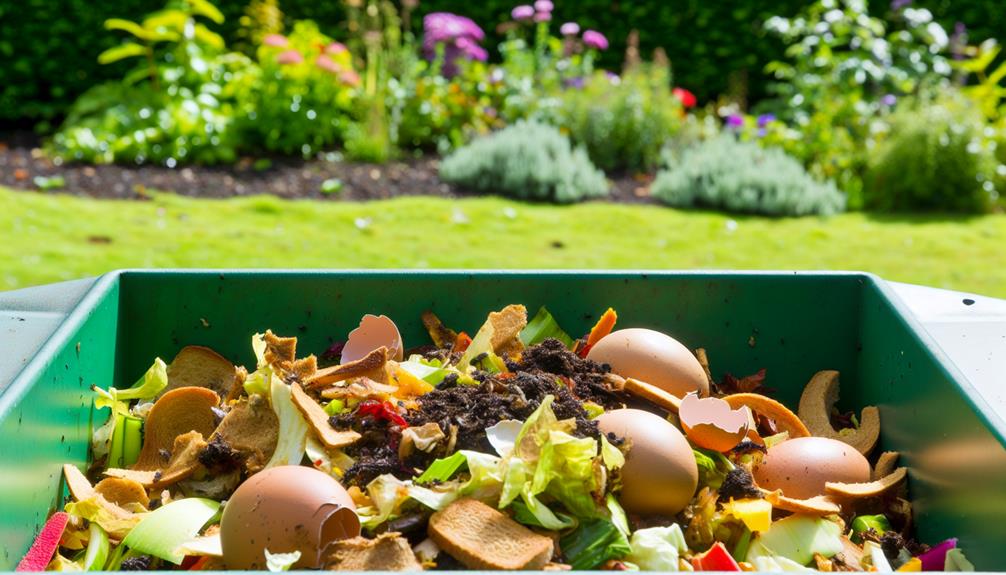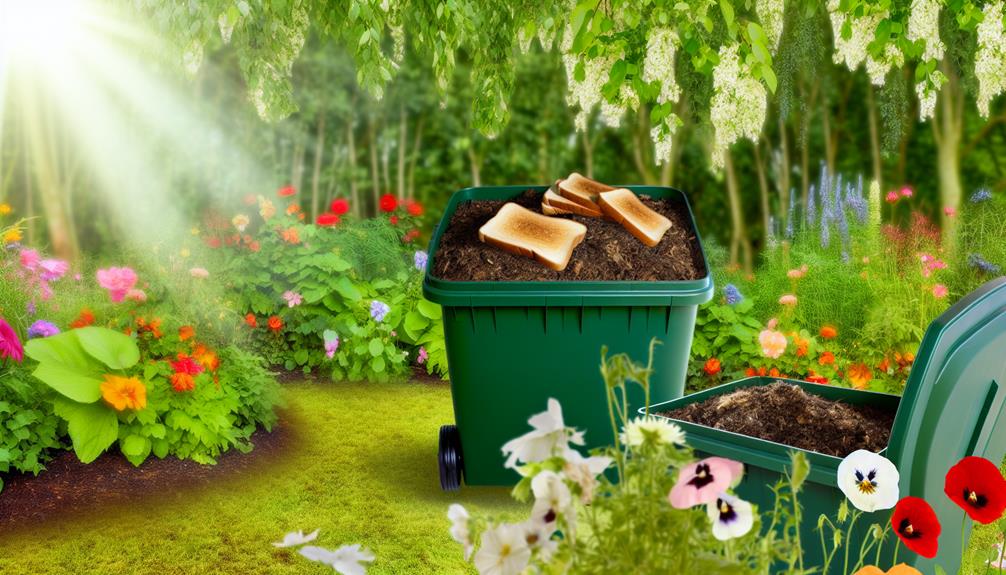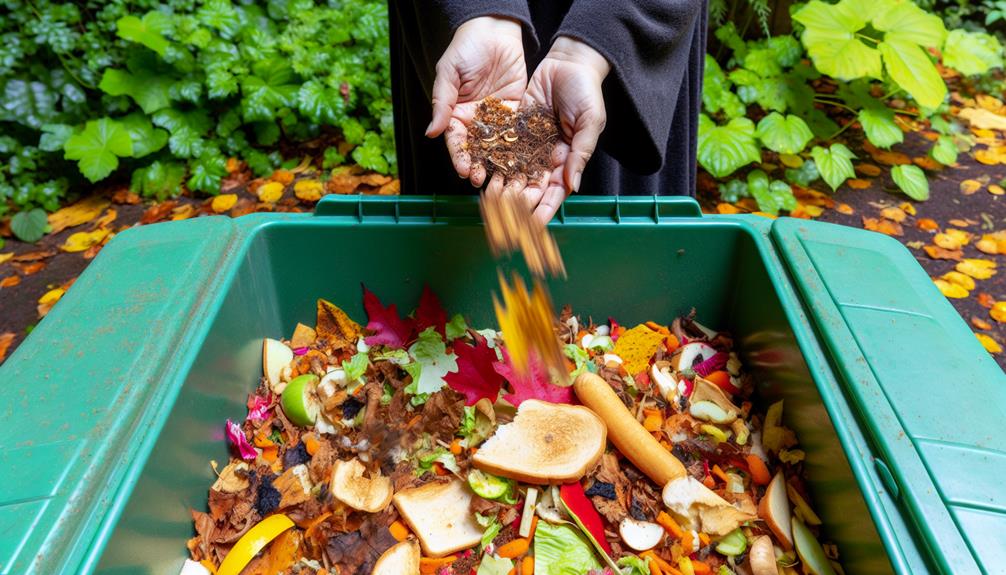

You can definitely compost toast. It’s a brown material rich in carbon, perfect for your compost pile. Break it into smaller pieces to speed up decomposition. Balance toast with green materials high in nitrogen, like vegetable scraps. Maintain proper moisture and aeration by regularly turning your compost.
Bury toast deep to avoid attracting pests and distribute it in moderate amounts. With these methods, you’ll prevent mold and guarantee the toast decomposes efficiently, enriching your soil. Continue to explore ways to improve your composting process.
Composting is a natural process that turns organic waste, like your leftover toast, into nutrient-rich soil. To get started, you need to understand the basics of composting, which involves breaking down organic materials through microbial activity.
First, gather your organic materials. These include kitchen scraps like fruit peels, vegetable cuttings, and, of course, leftover toast. It’s important to mix these with other organic waste such as coffee grounds, eggshells, and yard clippings. Balance is key; aim for a mix of green materials (rich in nitrogen) and brown materials (rich in carbon).
Next, select a compost bin. You can choose from various types, including outdoor compost bins, tumblers, or even simple open piles. Your choice depends on your space and commitment level. A closed bin might be better if you’re concerned about pests or have limited space.
Once you’ve got your bin, layer your organic materials, alternating between greens and browns. Keep it moist but not too wet, and turn the pile regularly to aerate it. This will speed up the decomposition process, transforming your waste into valuable compost for your garden.
Also Read: Can You Compost Branches?
The transformation of leftover toast into rich compost involves a fascinating interplay of microorganisms breaking down the starches and fibers. When you add toast to your compost bin, composting microbes begin the process of bread decomposition. These microbes, including bacteria and fungi, are essential in breaking down the carbohydrates and proteins in the bread.
To guarantee efficient decomposition, you should break the toast into smaller pieces. This increases the surface area, making it easier for the microbes to access the nutrients. Maintaining the right balance of green and brown materials is also vital. Toast counts as a brown material, rich in carbon, so you should balance it with green materials like vegetable scraps, which are high in nitrogen.
Moisture and aeration are key to speeding up the composting process. Keep your compost moist, like a damp sponge, but not waterlogged. Turning your compost pile regularly introduces oxygen, which the composting microbes need to thrive.
Transforming leftover bread into compost yields numerous environmental and practical benefits. First, by composting bread, you’re actively reducing waste. Instead of tossing stale bread into the trash where it would contribute to landfill mass, you’re giving it a new purpose. This reduction in waste helps decrease methane emissions from landfills, a significant contributor to greenhouse gases.

Moreover, composting bread enriches soil, making it more fertile and capable of supporting robust plant growth. Bread, rich in carbohydrates, breaks down quickly in a compost heap, providing essential nutrients that enhance the compost’s overall quality. This nutrient-rich compost can then be used in gardens, promoting healthier plants and more bountiful harvests.
To get started, simply add small pieces of bread to your compost bin. Make sure it’s mixed well with other compostable materials like fruit peels, vegetable scraps, and garden waste. This balanced mix ensures efficient decomposition and nutrient distribution.
Also Read: Can You Compost Bones?
While composting bread offers numerous benefits, it’s important to address potential pest issues to guarantee a hassle-free experience. Bread, including toast, can attract rodents and other pests if not managed properly. Implementing effective pest control strategies will help you keep your compost pile healthy and pest-free.
Here are some steps to minimize rodent attraction and manage pest concerns:
Also Read: Can You Compost Body Wash?
To prevent mold in your compost, make sure it stays well-aerated and properly balanced. Start with simple aeration techniques. Turning your compost pile regularly introduces oxygen, essential for decomposing organic matter efficiently. A pitchfork or a compost turner works well for this task.

Additionally, consider adding materials like straw or shredded newspaper to improve airflow.
Next, focus on moisture management. Your compost should feel like a wrung-out sponge—not too wet, not too dry. If it’s too damp, it creates an environment where mold thrives. To fix excess moisture, add dry materials like leaves or cardboard. Conversely, if your compost is too dry, sprinkle some water to adjust it.
Balancing green and brown materials is also important. Greens (like vegetable scraps) provide nitrogen, while browns (like dried leaves) offer carbon. Aim for a mix of about 3 parts brown to 1 part green. This balance helps maintain the right moisture level and prevents mold.
Yes, you can compost toast, but avoid toast with butter alternatives or jam ingredients that contain preservatives. For a community-focused compost, stick to plain toast to guarantee a healthier, more inclusive composting environment.
The decomposition rate of toast in compost depends on moisture levels. Keep your compost moist but not soggy to speed up the process. You’ll likely see toast breaking down within a few weeks. Enjoy your eco-friendly efforts!
Yes, break the toast into smaller pieces before composting. Smaller crumb sizes help increase the moisture content and speed up decomposition. Doing so also guarantees a more balanced compost, making you feel like a composting pro!
Yes, you can compost burnt or charred toast, but break it into smaller pieces first. This helps prevent mold growth and reduces compost odor. It’s a great way to contribute to the community’s sustainable practices.
Yes, you can compost toast with gluten-free ingredients! Don’t worry about gluten sensitivity; it won’t affect your compost. Don’t fall for composting myths. Join the community of eco-friendly composters and reduce food waste together!
You can compost toast, but do it correctly to avoid issues. Break it into small pieces to speed up decomposition.
Mix it well with other compost materials to prevent mold. Keep a balanced compost pile with greens and browns to avoid attracting pests.
Regularly turn your compost to maintain aeration and proper moisture levels. By following these steps, you’ll efficiently compost toast and contribute to a healthier garden and environment.
